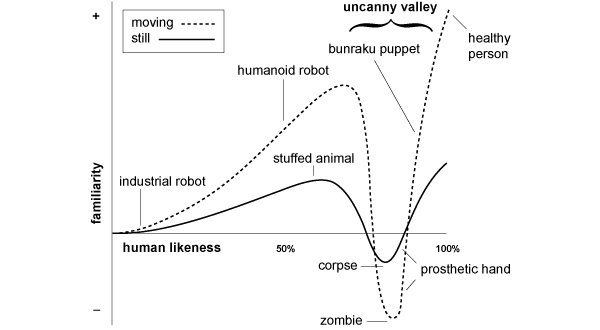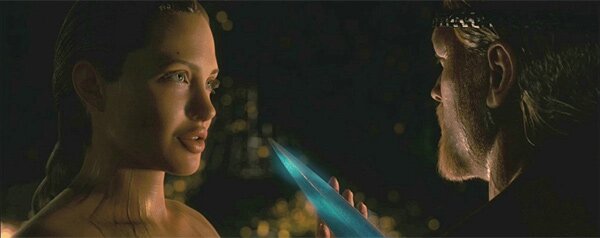As We Walk Through the Uncanny Valley
Introduction
As human beings, we are intrigued and somewhat obsessed with technology and the future; robots in science fiction is a reoccuring theme often used in films to depict the future, and perhaps soon enough, may become an everyday reality.
When we see humanlike robots in films or even in real life, we may naturally try to empathize with them. There is, however, a thin line and if the robot becomes too humanlike for our liking, our emotions make a strong u-turn into repulsion. This measurement of repulsive response is called the Uncanny Valley, a hypothesis introduced by Japanese roboticist Masahiro Mori in 1970. On a graph, the valley is a dip in positivity of human reaction.

Realistic character rendering from Final Fantasy: The Spirits Within
Wikipedia sums up The Uncanny Valley in these words:
…as a robot is made more humanlike in its appearance and motion, the emotional response from a human being to the robot will become increasingly positive and empathic until a point is reached beyond which the response quickly becomes that of strong repulsion. However, as the appearance and motion continue to become less distinguishable from a human being, the emotional response becomes positive once more and approaches human-to-human empathy levels.

Hypothesized emotional response of human subjects is plotted against anthropomorphism of a robot, following Mori's statements. The uncanny valley is the region of negative emotional response towards robots that seem "almost human". Movement amplifies the emotional response. -MacDorman, 2005.
The Uncanny Valley in Films
The uncanny valley effect is very evident in films, particularly in CGI animated fare. Examples that best represent this are Beowulf, The Polar Express, Final Fantasy: The Spirits Within and hinted at in the trailer, the forthcoming Avatar. The film industry takes this concept very seriously as negative reactions from moviegoers could hurt their bottom line. This is an interesting topic as a double-edged sword; audiences may feel let down if they think the CGI animation in a film is subpar or not detailed enough, however, if the filmmakers create too much realism, that could teeter into an uncanny valley effect.

Screen shot from Beowulf
Perhaps we’d like there to be clearer distinctions between the real and the artificial. Through the ever-advancing technology in moviemaking, the boundaries have been blurred to uncomfortable levels for some audiences. We see something that looks humanlike (such as any of the characters from the aforementioned films) but we know they aren’t human actors and it’s jarring as we try to comprehend this.
This doesn’t apply to computer generated animals, objects, or non-homosapiens for that matter; I mean nobody would be repulsed by Woody from Toy Story right? But make a computer generated human too human and the rules have changed.
Why?
It has been suggested that there are several reasons that underpin this theory, but the most interesting I have come across is the idea that these uncanny robots remind us that we aren’t immortal and death awaits us all. Morbid as it may sound, we begin digging our graves as soon as we’re born, and so we create defense mechanisms to deal with this. Meanwhile, an uncanny robot comes along and somehow raises our subconscious thoughts to the surface, using our own fears against us. We fear that we’re all just predetermined machine-like beings with little control over anything. A subject matter cleverly discussed in The Matrix.
Closely linked to our fear of death is the notion that we’re all replaceable, especially as we bear witness to astounding scientific achievements over the years. Couple this with films such as Artificial Intelligence, I, Robot, The Terminator, and The Matrix and we’d be right to think that robots and technology will be able to outlive and outsmart us in all walks of life. As a highly intelligent and evolved species who have fought hard for our survival, it is natural that we would feel threatened by uncanny robots, so seeing them on-screen might aggravate our fears and insecurities.
How Far Should We Go?
The challenge for designers and filmmakers is, how far should they go? Perhaps the answer lies in context. For example, if a robot lives in genres such as fantasy and science fiction, then we may be able to cognitively accept it as looking lifelike, but due to the environment, we are always aware that it isn’t. On the flipside, imagine the same robot in 2009 walking through an iconic city, and it suddenly becomes intimidating and real, at which point we walk through the valley of revulsion.

Screen shot from Polar Express
Closing
This is a complicated topic with many more theories and discussion points that I urge you to investigate further. This subject isn’t only skin deep and it raises many questions about the human psyche and the world we live in. It also begs us to question our reality. Film is one medium where reality and fiction blend but is this true of our everyday lives?
For all we know we might be walking amongst uncanny robots already, after all, how would we know?

Rob Mills is a Writer, Project Manager, and huge film fan. He has lent his skills to the BBC, Mark Boulton Design, Carsonified and now Huw David Design. When he isn’t in the cinema, he can be found writing for various websites and publications, including his blog. You can also follow Rob on .


I really like the Avatar 3D film, especially the story line, not only it brings a very new feelings but eye opening ideas of humanity. I heard the New Avatar 2 is comming soon, cannot wait to watch it again…!
With havin so much written content do you ever run into any issues of plagorism or copyright violation? My site has a lot of unique content I’ve either authored myself or outsourced but it appears a lot of it is popping it up all over the web without my authorization. Do you know any techniques to help reduce content from being ripped off? I’d really appreciate it.
I wish I did.
Though I’m sure it happens often, I believe people know where to go for great content and they have a fairly good memory when it comes to where they saw certain things. When they see something that has been taken from another site, they aren’t afraid to push the panic button and it soon comes crashing down for that site. With published content on a well traversed website, it isn’t too difficult to say who really wrote and published it. A simple email to the offending parties telling them to take it down or give credit is all it usually takes. If they don’t listen when you’re polite, you can be forceful. If they don’t listen, you can talk to their web host because there are clauses in their contracts that prohibits that sort of thing.
I don’t know if there is a way to stop it completely or even slow it down, but there are certain things you can do to make it difficult for them.